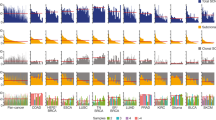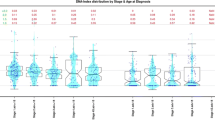Abstract
Osteosarcoma (OS) is characterized by chromosomal instability and high copy number gene amplification. The breakage–fusion–bridge (BFB) cycle is a well-established mechanism of genome instability in tumors and in vitro models used to study the origins of complex chromosomal rearrangements and cancer genome amplification. To determine whether the BFB cycle could be increasing the de novo rate of formation of cytogenetic aberrations in OS, the frequency of anaphase bridge configurations and dicentric chromosomes in four OS cell lines was quantified. An increased level of anaphase bridges and dicentrics was observed in all the OS cell lines. There was also a strong association between the frequencies of anaphase bridges, dicentrics, centrosomal anomalies, and multipolar mitotic figures in all the OS cell lines, indicating a possible link in the mechanisms that led to the structural and numerical instabilities observed in OS. In summary, this study has provided strong support for the role of the BFB cycle in generating the extensive structural chromosome aberrations, as well as cell-to-cell cytogenetic variation observed in OS, thus conferring the genetic diversity for OS tumor progression.




Similar content being viewed by others
References
Akerman M, Dreinhofer K, Rydholm A, Willen H, Mertens F, Mitelman F, Mandahl N (1996) Cytogenetic studies on fine-needle aspiration samples from osteosarcoma and Ewing’s sarcoma. Diagn Cytopathol 15:17–22
Al-Romaih K, Bayani J, Vorobyova J, Karaskova J, Park PC, Zielenska M, Squire JA (2003) Chromosomal instability in osteosarcoma and its association with centrosome abnormalities. Cancer Genet Cytogenet 144:91–99
Atiye J, Wolf M, Kaur S, Monni O, Bohling T, Kivioja A, Tas E, Serra M, Tarkkanen M, Knuutila S (2005) Gene amplifications in osteosarcoma-CGH microarray analysis. Genes Chromosomes Cancer 42:158–163
Bayani J, Zielenska M, Pandita A, Al-Romaih K, Karaskova J, Harrison K, Bridge JA, Sorensen P, Thorner P, Squire JA (2003) Spectral karyotyping identifies recurrent complex rearrangements of chromosomes 8, 17, and 20 in osteosarcomas. Genes Chromosomes Cancer 36:7–16
Bosco G, Haber JE (1998) Chromosome break-induced DNA replication leads to nonreciprocal translocations and telomere capture. Genetics 150:1037–1047
Cahill DP, Kinzler KW, Vogelstein B, Lengauer C (1999) Genetic instability and darwinian selection in tumours. Trends Cell Biol 9:M57–60
Eichler EE (1998) Masquerading repeats: paralogous pitfalls of the human genome. Genome Res 8:758–762
Ghadimi BM, Sackett DL, Difilippantonio MJ, Schrock E, Neumann T, Jauho A, Auer G, Ried T (2000) Centrosome amplification and instability occurs exclusively in aneuploid, but not in diploid colorectal cancer cell lines, and correlates with numerical chromosomal aberrations. Genes Chromosomes Cancer 27:183–190
Gisselsson D (2003) Chromosome instability in cancer: how, when, and why? Adv Cancer Res 87:1–29
Gisselsson D, Hoglund M, Mertens F, Mandahl N (1999) Variable stability of chromosomes containing amplified alpha-satellite sequences in human mesenchymal tumours. Chromosoma 108:271–277
Gisselsson D, Pettersson L, Hoglund M, Heidenblad M, Gorunova L, Wiegant J, Mertens F, Dal Cin P, Mitelman F, Mandahl N (2000) Chromosomal breakage–fusion–bridge events cause genetic intratumor heterogeneity. Proc Natl Acad Sci USA 97:5357–5362
Gisselsson D, Jonson T, Yu C, Martins C, Mandahl N, Wiegant J, Jin Y, Mertens F, Jin C (2002) Centrosomal abnormalities, multipolar mitoses, and chromosomal instability in head and neck tumours with dysfunctional telomeres. Br J Cancer 87:202–207
Gisselsson D, Palsson E, Yu C, Mertens F, Mandahl N (2004) Mitotic instability associated with late genomic changes in bone and soft tissue tumours. Cancer Lett 206:69–76
Gollin SM (2004) Chromosomal instability. Curr Opin Oncol 16:25–31
Hoffelder DR, Luo L, Burke NA, Watkins SC, Gollin SM, Saunders WS (2004) Resolution of anaphase bridges in cancer cells. Chromosoma 112:389–397
Jin Y, Jin C, Wennerberg J, Hoglund M, Mertens F (2001) Cytogenetic and fluorescence in situ hybridization characterization of chromosome 8 rearrangements in head and neck squamous cell carcinomas. Cancer Genet Cytogenet 130:111–117
Kaufman RJ, Sharp PA, Latt SA (1983) Evolution of chromosomal regions containing transfected and amplified dihydrofolate reductase sequences. Mol Cell Biol 3:699–711
Lim G, Karaskova J, Vukovic B, Bayani J, Beheshti B, Bernardini M, Squire JA, Zielenska M (2004) Combined spectral karyotyping, multicolor banding, and microarray comparative genomic hybridization analysis provides a detailed characterization of complex structural chromosomal rearrangements associated with gene amplification in the osteosarcoma cell line MG-63. Cancer Genet Cytogenet 153:158–164
Lim G, Karaskova J, Beheshti B, Vukovic B, Bayani J, Selvarajah S, Watson SK, Lam WL, Zielenska M, Squire JA (2005) An integrated mBAND and submegabase resolution tiling set (SMRT) CGH array analysis of focal amplification, microdeletions, and ladder structures consistent with breakage–fusion–bridge cycle events in osteosarcoma. Genes Chromosomes Cancer 42:392–403
Lo AW, Sprung CN, Fouladi B, Pedram M, Sabatier L, Ricoul M, Reynolds GE, Murnane JP (2002) Chromosome instability as a result of double-strand breaks near telomeres in mouse embryonic stem cells. Mol Cell Biol 22:4836–4850
Loeb LA (1991) Mutator phenotype may be required for multistage carcinogenesis. Cancer Res 51:3075–3079
Masuda A, Takahashi T (2002) Chromosome instability in human lung cancers: possible underlying mechanisms and potential consequences in the pathogenesis. Oncogene 21:6884–6897
McClintock B (1941) The stability of broken ends of chromosomes in Zea mays. Genetics 26:234–282
Mertens F, Mandahl N, Orndal C, Baldetorp B, Bauer HC, Rydholm A, Wiebe T, Willen H, Akerman M, Heim S et al (1993) Cytogenetic findings in 33 osteosarcomas. Int J Cancer 55:44–50
Michor F, Iwasa Y, Vogelstein B, Lengauer C, Nowak MA (2005) Can chromosomal instability initiate tumorigenesis? Semin Cancer Biol 15:43–49
Mitelman F (1995) An International System for Human Cytogenetic Nomenclature (ISCN 1995). S. Karger, Basel
Mussman JG, Horn HF, Carroll PE, Okuda M, Tarapore P, Donehower LA, Fukasawa K (2000) Synergistic induction of centrosome hyperamplification by loss of p53 and cyclin E overexpression. Oncogene 19:1635–1646
Nowak MA, Komarova NL, Sengupta A, Jallepalli PV, Shih Ie M, Vogelstein B, Lengauer C (2002) The role of chromosomal instability in tumor initiation. Proc Natl Acad Sci USA 99:16226–16231
Pfeiffer P, Goedecke W, Kuhfittig-Kulle S, Obe G (2004) Pathways of DNA double-strand break repair and their impact on the prevention and formation of chromosomal aberrations. Cytogenet Genome Res 104:7–13
Reshmi SC, Saunders WS, Kudla DM, Ragin CR, Gollin SM (2004) Chromosomal instability and marker chromosome evolution in oral squamous cell carcinoma. Genes Chromosomes Cancer 41:38–46
Saunders W (2005) Centrosomal amplification and spindle multipolarity in cancer cells. Semin Cancer Biol 15:25–32
Scheel C, Schaefer KL, Jauch A, Keller M, Wai D, Brinkschmidt C, van Valen F, Boecker W, Dockhorn-Dworniczak B, Poremba C (2001) Alternative lengthening of telomeres is associated with chromosomal instability in osteosarcomas. Oncogene 20:3835–3844
Shimizu N, Shingaki K, Kaneko-Sasaguri Y, Hashizume T, Kanda T (2005) When, where and how the bridge breaks: anaphase bridge breakage plays a crucial role in gene amplification and HSR generation. Exp Cell Res 302:233–243
Squire JA, Pei J, Marrano P, Beheshti B, Bayani J, Lim G, Moldovan L, Zielenska M (2003) High-resolution mapping of amplifications and deletions in pediatric osteosarcoma by use of CGH analysis of cDNA microarrays. Genes Chromosomes Cancer 38:215–225
Stewenius Y, Gorunova L, Jonson T, Larsson N, Hoglund M, Mandahl N, Mertens F, Mitelman F, Gisselsson D (2005) Structural and numerical chromosome changes in colon cancer develop through telomere-mediated anaphase bridges, not through mitotic multipolarity. Proc Natl Acad Sci USA 102:5541–5546
Stock C, Kager L, Fink FM, Gadner H, Ambros PF (2000) Chromosomal regions involved in the pathogenesis of osteosarcomas. Genes Chromosomes Cancer 28:329–336
Tarkkanen M, Karhu R, Kallioniemi A, Elomaa I, Kivioja AH, Nevalainen J, Bohling T, Karaharju E, Hyytinen E, Knuutila S et al (1995) Gains and losses of DNA sequences in osteosarcomas by comparative genomic hybridization. Cancer Res 55:1334–1338
Toledo F, Le Roscouet D, Buttin G, Debatisse M (1992) Co-amplified markers alternate in megabase long chromosomal inverted repeats and cluster independently in interphase nuclei at early steps of mammalian gene amplification. EMBO J 11:2665–2673
Tomescu O, Barr FG (2001) Chromosomal translocations in sarcomas: prospects for therapy. Trends Mol Med 7:554–559
Trask BJ, Hamlin JL (1989) Early dihydrofolate reductase gene amplification events in CHO cells usually occur on the same chromosome arm as the original locus. Genes Dev 3:1913–1925
Tsuchiya T, Sekine K, Hinohara S, Namiki T, Nobori T, Kaneko Y (2000) Analysis of the p16INK4, p14ARF, p15, TP53, and MDM2 genes and their prognostic implications in osteosarcoma and Ewing sarcoma. Cancer Genet Cytogenet 120:91–98
Van Hooser AA, Ouspenski II, Gregson HC, Starr DA, Yen TJ, Goldberg ML, Yokomori K, Earnshaw WC, Sullivan KF, Brinkley BR (2001) Specification of kinetochore-forming chromatin by the histone H3 variant CENP-A. J Cell Sci 114:3529–3542
Wang Y, Putnam CD, Kane MF, Zhang W, Edelmann L, Russell R, Carrion DV, Chin L, Kucherlapati R, Kolodner RD, Edelmann W (2005) Mutation in Rpa1 results in defective DNA double-strand break repair, chromosomal instability and cancer in mice. Nat Genet 37:750–755
Warburton PE, Cooke CA, Bourassa S, Vafa O, Sullivan BA, Stetten G, Gimelli G, Warburton D, Tyler-Smith C, Sullivan KF, Poirier GG, Earnshaw WC (1997) Immunolocalization of CENP-A suggests a distinct nucleosome structure at the inner kinetochore plate of active centromeres. Curr Biol 7:901–904
Zhu C, Mills KD, Ferguson DO, Lee C, Manis J, Fleming J, Gao Y, Morton CC, Alt FW (2002) Unrepaired DNA breaks in p53-deficient cells lead to oncogenic gene amplification subsequent to translocations. Cell 109:811–821
Zielenska M, Bayani J, Pandita A, Toledo S, Marrano P, Andrade J, Petrilli A, Thorner P, Sorensen P, Squire JA (2001) Comparative genomic hybridization analysis identifies gains of 1p35 approximately p36 and chromosome 19 in osteosarcoma. Cancer Genet Cytogenet 130:14–21
Zielenska M, Marrano P, Thorner P, Pei J, Beheshti B, Ho M, Bayani J, Liu Y, Sun BC, Squire JA, Hao XS (2004) High-resolution cDNA microarray CGH mapping of genomic imbalances in osteosarcoma using formalin-fixed paraffin-embedded tissue. Cytogenet Genome Res 107:77–82
Acknowledgement
This work was supported by funding from the National Cancer Institute of Canada and Canadian Institute of Health Research (Ph.D. fellowship to S.S.).
Author information
Authors and Affiliations
Corresponding author
Additional information
Communicated by E.A. Nigg
Rights and permissions
About this article
Cite this article
Selvarajah, S., Yoshimoto, M., Park, P.C. et al. The breakage–fusion–bridge (BFB) cycle as a mechanism for generating genetic heterogeneity in osteosarcoma. Chromosoma 115, 459–467 (2006). https://doi.org/10.1007/s00412-006-0074-4
Received:
Revised:
Accepted:
Published:
Issue Date:
DOI: https://doi.org/10.1007/s00412-006-0074-4




